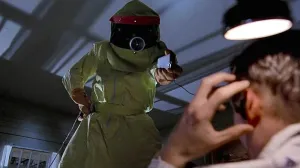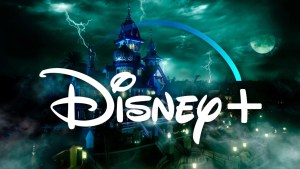In 2013, The Purge debuted in theaters and almost instantly kicked off a cultural phenomenon that far exceeded any installment in the horror film franchise. Hitting theaters this summer is the prequel The First Purge which chronicles, well, the first Purge.
Videos by ComicBook.com
Set in the not too distant future, the series explores an America where, in hopes of both culling lower status citizens and allowing individuals to embrace their violent tendencies, all crime is legal for a 12-hour period, referred to as “The Purge.” The franchise presents a horrifying scenario, yet the initial installment confined the action to a single home while the second and third films leaned more into the action-heavy side of filmmaking, putting the horror on the backburner.
The Purge is far from the first film to explore these themes, yet it has resonated deeply with audiences based on our cultural climate of violence and the disconnect between the rich and the poor. As politicians get richer, citizens get poorer, all while mass shootings occur at such a regular rate that organizations barely address these incidents if there aren’t enough victims.
The franchise has become such a cultural touchstone that referring to a “Purge” has become a regular occurrence, with the concept now merely referring to any night in which someone wants to ignore cultural taboos and pretend like nothing matters for a brief period of time.
For those of you excited by what the future holds for the Purge franchise, make sure to check out these films!
‘The Strangers’ (2008)

Considered by many to be the seminal home invasion film, the original The Purge owes a lot to this underseen horror film.
When a couple heads to a remote cabin after celebrating a friend’s wedding, their night is interrupted by masked individuals surrounding their home. The intruders never make their motivations clear, as they rarely speak and hide their faces behind innocuous masks.
The antagonists in The Purge adopted the use of masks while trying to break into a family’s home, but with their activities technically being legal during the annual Purge, the attackers were able to ditch the masks and reveal that their actual faces were even more horrifying, as they looked like normal people. The Strangers helped pave the way for not just The Purge, but countless other home invasion horror films.
It’s worth noting that the 2006 French film Ils (Them) is another notable entry in the home invasion subgenre, which some prefer over Strangers, yet that film doesn’t feature as iconic disguises as the 2008 film, which became a regular facet of the Purge films.
‘You’re Next’ (2013)
While You’re Next was technically released after The Purge (which is possibly to blame for its underwhelming box office performance), the film initially premiered in 2011.
Clearly inspired by The Strangers, this film featured a family reunion at a vacation house which masked intruders violently interrupted. Once again, intruders sported masks with blankly innocent expressions of animals, an intimidating juxtaposition to their terrifying crimes. Whereas The Strangers featured attackers who were motivated by nothing more than their morbidity, You’re Next‘s invasion was financial in inspiration, depicting the lengths that some would go to in hopes of climbing to the next social strata.
The film has many thrilling moments, but it’s as much an ironic take on the home invasion subgenre as a worthy entry into it, delivering both horror and humor.
‘Escape from New York’ (1981)

A defining dystopic action-thriller, John Carpenter’s Escape from New York helped the filmmaker expand out of the horror mold after Halloween and The Fog to deliver audiences one of the greatest badasses in all of cinema with Kurt Russell’s Snake Plissken.
Set in 1997, the island of Manhattan has been converted into a maximum security wasteland where society’s worst criminals are sent to live out the rest of their days. After Air Force One is hijacked and the president is brought into the warzone, it’s up to former military man Plissken to get behind enemy lines and bring the president back safely.
The latter installments in the Purge franchise were clearly inspired by the Carpenter classic, as the second film focused on a variety of different characters throughout a city while the third film involved escorting a politician to safety. Carpenter also claimed that it was the political climate that inspired him to write the script, much like The Purge being a reflection of our current society.
‘The Warriors’ (1979)
A less dystopic action thriller, The Warriors instead took a more grounded approach to a violent tale, focusing instead on gang violence over an entire society embracing their violent tendencies.
After a gang is framed for the murder of a prominent gang leader, the group of friends must make it from the north end of the Bronx to their home territory in the south end of Brooklyn, all while every gang in New York City sets their sights on taking them down.
The action in this film sprawls an entire city, with the film’s narrative incorporating a stylized interpretation of gangs around the city, with some dressing as baseball players while others opt to adorn themselves in overalls. In the latter two Purge films, our heroes regularly encounter different groups of attackers who all utilize similar outfits for the festivities, whether they are unified by their masks or their choice of firepower.
‘Assault on Precinct 13’ (1976)
Another action-thriller from John Carpenter (which pre-dates the horror films for which he’d earn his legacy), this film shows off the filmmaker’s restraint, due in large part to his limited budget.
After a father kills a gang member in retribution for his daughter’s murder, he seeks refuge in a decrepit police precinct that is in its last hours before closure. Seeking retaliation for the gang leader’s murder, hordes of criminals descend upon precinct 13 in hopes of killing whoever is inside. Criminals and cops band together to stave off the intruders, setting aside their differences in hopes of survival.
The original Purge featured a family offering refuge to a man being pursued by attackers, with the antagonists assuring the family they’d be safe if they sacrificed the man they saved. Similarly, the events of Assault on Precinct 13 could have been avoided if the police officers inside offered up the man who killed a gang leader, as the film features the invasion themes seen in the first Purge while being more action-oriented than horror.
‘The Raid’ (2011)

A spiritual successor to Assault on Precinct 13, The Raid replaces firearms with fists and feet to create one of the best action films of the decade.
An elite police squad is sent into a high-rise to bring a drug lord to justice, with the mission so secretive that many of the higher-ups in the police department are unaware of its existence. When a young resident in the apartment building alerts the drug lord of the police presence, he offers free rent to anyone who kills the police squad, kicking off a series of deadly confrontations featuring the martial artist Pencak Silat.
From a filmmaking perspective, The Raid and The Purge are drastically different, with the films having much more in common on a conceptual level. Both properties feature characters confined to small spaces who must fight for their survival, with The Raid condensing the sprawling mayhem of the Purge universe to one building, as each level the police squad ascends bringing the danger to higher levels.
‘Society’ (1989)
The sci-fi body horror Society is drastically different from The Purge, both in concept and in execution. However, if the most interesting element of the Purge series is its portrayals of the rich, then Society might be right up your alley.
After receiving a bizarre audio tape of his wealthy family engaging in vile sexual and violent acts, a high school student begins trying to investigate the tape’s origins. The deeper he gets into a conspiracy of the town’s wealthy and elite, the deeper the mystery gets, with the boy eventually discovering the high-class residents of the town are actually a different species. In one of the most disgusting and impressive special effects sequences of the ’80s, the rich literally feed off the poor, draining them of their nutrients.
The Purge regularly shows off the disparity between the rich and the poor, but that disparity doesn’t get much more literal than in Society. If you’ve ever thought that wealthy politicians couldn’t possibly be human for the policies they vote into practice, Society may prove that you’re right.








